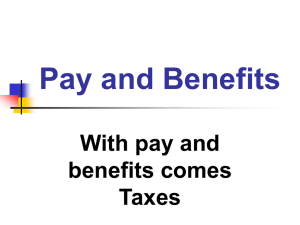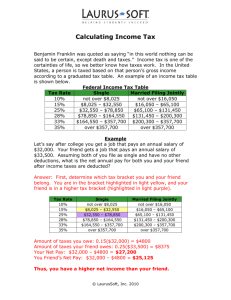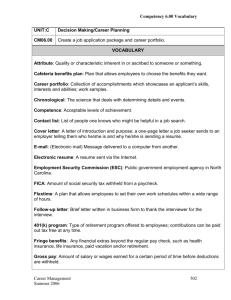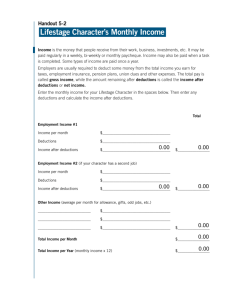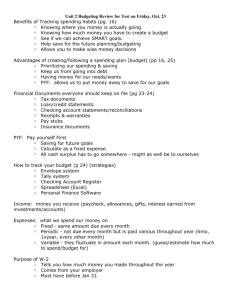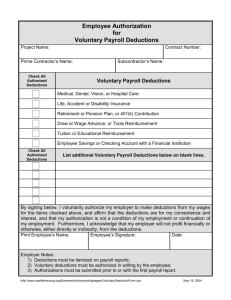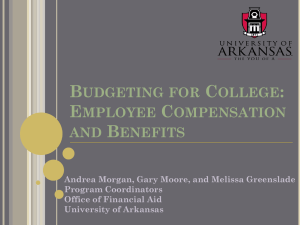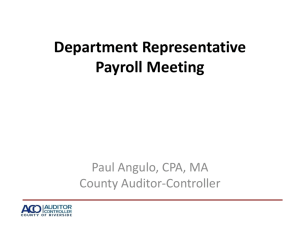What Happened to My Paycheck? A Guide to Payroll Deductions
advertisement
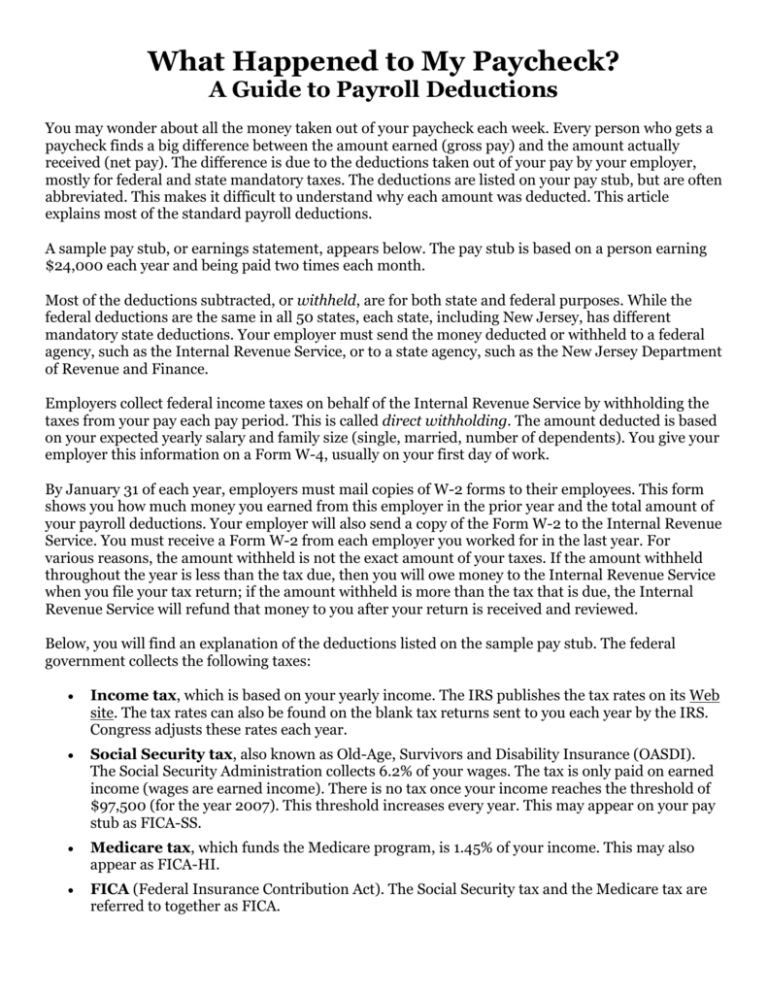
What Happened to My Paycheck? A Guide to Payroll Deductions You may wonder about all the money taken out of your paycheck each week. Every person who gets a paycheck finds a big difference between the amount earned (gross pay) and the amount actually received (net pay). The difference is due to the deductions taken out of your pay by your employer, mostly for federal and state mandatory taxes. The deductions are listed on your pay stub, but are often abbreviated. This makes it difficult to understand why each amount was deducted. This article explains most of the standard payroll deductions. A sample pay stub, or earnings statement, appears below. The pay stub is based on a person earning $24,000 each year and being paid two times each month. Most of the deductions subtracted, or withheld, are for both state and federal purposes. While the federal deductions are the same in all 50 states, each state, including New Jersey, has different mandatory state deductions. Your employer must send the money deducted or withheld to a federal agency, such as the Internal Revenue Service, or to a state agency, such as the New Jersey Department of Revenue and Finance. Employers collect federal income taxes on behalf of the Internal Revenue Service by withholding the taxes from your pay each pay period. This is called direct withholding. The amount deducted is based on your expected yearly salary and family size (single, married, number of dependents). You give your employer this information on a Form W-4, usually on your first day of work. By January 31 of each year, employers must mail copies of W-2 forms to their employees. This form shows you how much money you earned from this employer in the prior year and the total amount of your payroll deductions. Your employer will also send a copy of the Form W-2 to the Internal Revenue Service. You must receive a Form W-2 from each employer you worked for in the last year. For various reasons, the amount withheld is not the exact amount of your taxes. If the amount withheld throughout the year is less than the tax due, then you will owe money to the Internal Revenue Service when you file your tax return; if the amount withheld is more than the tax that is due, the Internal Revenue Service will refund that money to you after your return is received and reviewed. Below, you will find an explanation of the deductions listed on the sample pay stub. The federal government collects the following taxes: • Income tax, which is based on your yearly income. The IRS publishes the tax rates on its Web site. The tax rates can also be found on the blank tax returns sent to you each year by the IRS. Congress adjusts these rates each year. • Social Security tax, also known as Old-Age, Survivors and Disability Insurance (OASDI). The Social Security Administration collects 6.2% of your wages. The tax is only paid on earned income (wages are earned income). There is no tax once your income reaches the threshold of $97,500 (for the year 2007). This threshold increases every year. This may appear on your pay stub as FICA-SS. • Medicare tax, which funds the Medicare program, is 1.45% of your income. This may also appear as FICA-HI. • FICA (Federal Insurance Contribution Act). The Social Security tax and the Medicare tax are referred to together as FICA. New Jersey collects the following taxes: • State income tax, which is 1.4% of an employee’s income. There are thresholds for this tax. If the employee is single and the total income for the year was less than $10,000, no state income tax is due. If the employee is married and the total income for the year is less than $20,000, no state income tax is due. • NJSUI (New Jersey State Unemployment Insurance), or unemployment tax, which, for the year 2007, is based on the first $26,600 of wages. The starting rate for a new employer is 2.6825%, with an employee contribution of .3825%, plus a workforce charge of .0425%, resulting in a net employee charge of .425%. • NJSDI, or New Jersey State Disability Insurance tax. New Jersey is one of five states, along with the territory of Puerto Rico, that require employers to provide disability insurance coverage. The contributions come from both the employer and the employee. The tax rate is 0.50% from each. There are other deductions that may come out of your pay. You may pay a portion of your medical and dental insurance. You may also be putting money aside toward a Flexible Spending Account (FSA). Some of your wages may be garnished, as part of a wage execution on a judgment. In New Jersey, the amount that can be garnished is the lesser of 25% of your net pay, or 10% of the gross pay. Finally, you may have deductions for contributions to a 401(k) plan. Most employers use a tax software package that calculates deductions for them. The deductions taken out of your paycheck depend on the information provided to the employer regarding marital status and number of dependents. To verify that the deductions coming out of your paycheck are correct, you may use the Withholding Allowance Calculator located on the Internal Revenue Service Web site. SAMPLE PAY STUB Earnings/Gross Pay This Period 6/1/07-6/15/07 $1,000 Deductions: Federal Income Tax $133.00 Social Security Tax $62.00 Medicare Tax $14.50 NJ State Income Tax $14.00 NJ SUI/SDI Tax $9.00 Medical $50.00 Dental $10.00 Medical FSA $5.00 Garnishment $100.00 Contributions 0 NET PAY $602.50 Year to Date $13,000 $1.463.00 $806.00 $188.50 $182.00 $117.00 $650.00 $10.00 $65.00 $350.00 0 This article appeared in the July-August 2007 edition of Looking Out for Your Legal Rights®.

